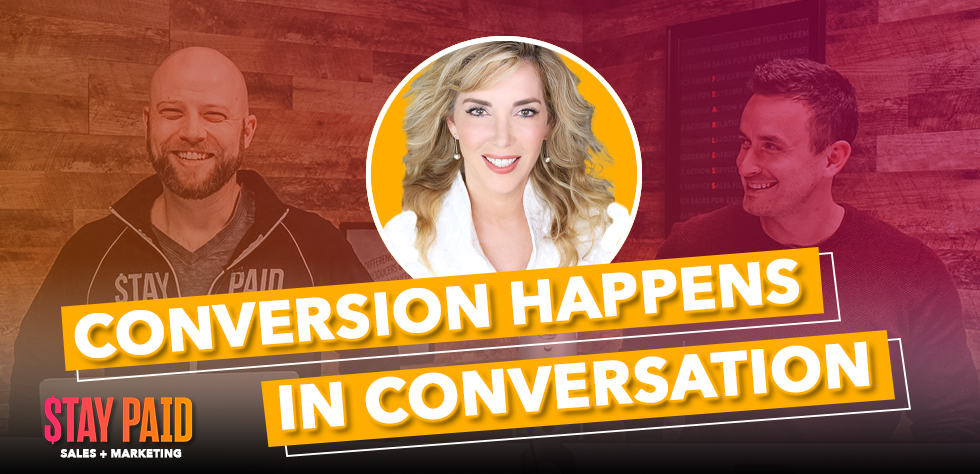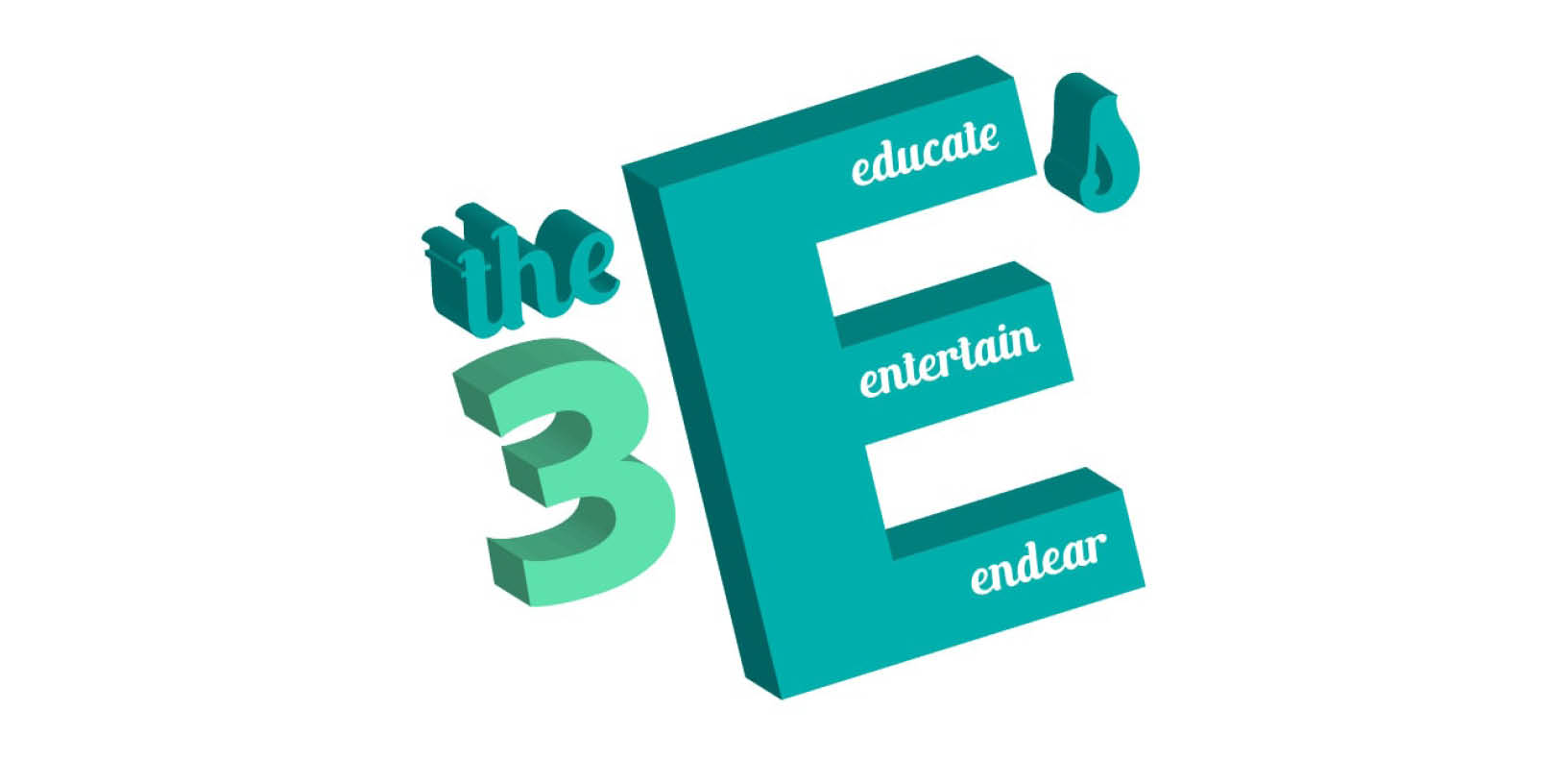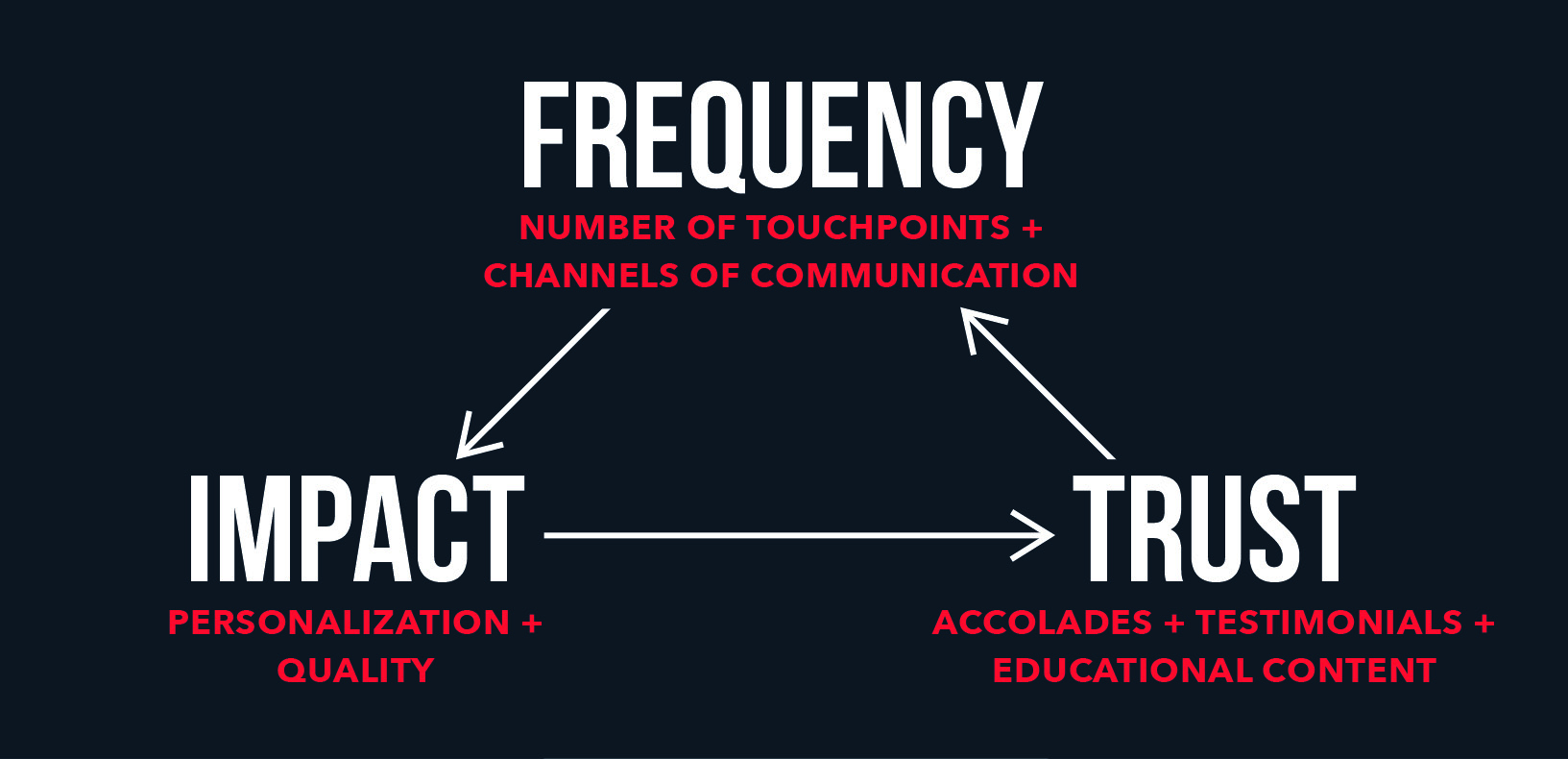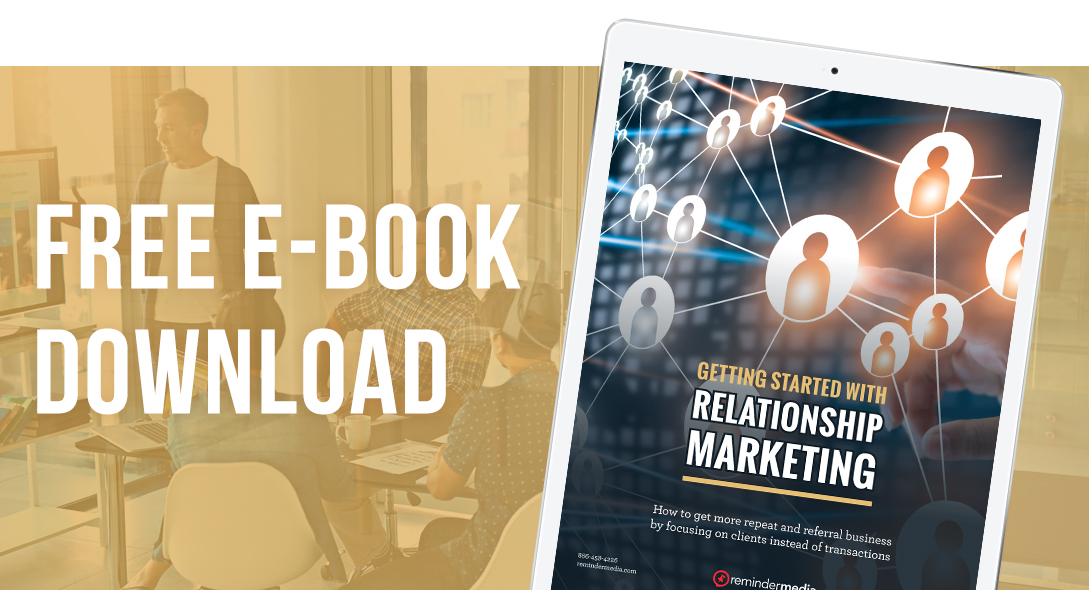Of all the types of marketing strategies out there, the one I’m about to discuss with you is easy to understand, simple to implement, and, above all, exceptionally effective. And whether you’re a real estate agent, independent financial advisor, insurance broker, roofer, landscaper, interior designer, or any other type of small business owner, you can start using it today.
It’s called F.I.T. marketing, and at its core are three criteria against which you can evaluate your entire marketing plan—every strategy and every tactic, whether it’s a paid online ad, an email, a piece of direct mail, a radio spot, a blog, a podcast, or something else.
What is F.I.T. marketing?
F.I.T. marketing refers to:
- Frequency: Rarely is marketing a one-and-done endeavor. To be effective, your marketing needs to be delivered and seen frequently, consistently, and across a wide variety of channels.
- Impact: The majority of what passes for marketing is ignored, deleted, or tossed in the trash. To have an impact, your marketing must offer the recipient value.
- Trust: Before a prospect will do business with you, you need to earn their trust. Your marketing must build their confidence in you and in your product or service.
Each element of F.I.T. marketing supports the other two, and your marketing needs to include all three to optimize its potential to attract and convert clients.
Ideas like frequency, impact, and trust are certainly not new to you. However, you may not be implementing them to their fullest as individual tactics. You may not have thought of them together as a coherent approach to marketing either. What follows explains why you should.
F is for frequency: The frequency illusion
Maybe you’ve recently bought a new car—let’s say it’s a blue convertible (nice). In your travels to the grocery store, to pick up the kids after soccer practice, or on the way home from a night out, you start to notice a large number of blue convertibles on the road. Suddenly, they’re everywhere!
Weird, yes, but not uncommon.
You’re experiencing the frequency illusion: a cognitive bias that makes it seem like something you hadn’t noticed before has abruptly and pervasively invaded your world. It’s the result of your reticular activating system, or RAS, working alongside two psychological phenomena: selective attention and confirmation bias.
The RAS is a collection of nerves located at the brain stem that allows us to focus on some things while filtering out others. Like everything else about the brain, exactly how it works can be difficult to understand. Even so, among its several functions, which include regulating consciousness, the RAS enables us to suddenly hear our name amid the conversational din in a crowded room.

Your reticular activating system protects you from stimulus overload by allowing you to focus on some things while filtering out others.
If we think about the RAS as the cook in a kitchen, then we can think of selective attention and confirmation bias as the ingredients. When the RAS (the cook) combines selective attention and confirmation bias (the ingredients) it creates the frequency illusion.
We routinely see confirmation bias at work in politics. Someone who opposes a specific issue will find information to back up their position. They’ll interpret the news in ways that support what they believe. And they’ll and remember details of debates, for example, that reinforces their attitudes.
Throw in a pinch of the recency effect, our uneasiness when presented with randomness, belief in synchronicity, and how we underestimate the frequency of coincidence, and you’ve got the makings of a belief that what we’ve recently noticed is, in fact, new and to be found everywhere.
And once we believe that, then it’s only a short step to thinking it’s also important and popular—and just about anything that is deemed important and popular will gain our more focused attention.
How the frequency illusion can be used in marketing
So what does all this mean for your marketing?
In order for the frequency illusion to have an effect, you must first make people aware of your brand—it’s the first step in any sales funnel. Even those who may never do business with you, if made aware of your product or service, could recommend you to someone in need of exactly what you offer.

In order for the frequency illusion to have an effect, you must first find a way to stand out and make people aware of your brand.
You need to ensure that your marketing stands out to be noticed. Placement, content, design, quality, timing, guerrilla tactics—all these can be managed within your marketing strategy to rise above the proverbial noise.
Once awareness is achieved, you want to retarget those who have expressed an interest.
These are your best prospects and most likely to give you a higher ROI because they’ve already either clicked, subscribed, downloaded, or visited. It’s worth the effort and resources: the click-through rate for retargeting ads is 10 times more than that of display ads, while website visitors who are later retargeted with display ads are 70% more likely to convert on your website.
Repeatedly expose them to your brand and you’ll start to activate the frequency illusion in them.

Visitors to your website that you later retarget with display ads are 70% more likely to convert.
Finally, the frequency illusion justifies omnichannel marketing—the use of all channels, all devices, and all platforms. You want your brand to be seen everywhere you can possibly put it. By using multiple channels, your prospects are frequently exposed to your brand without being made to feel like you’re stalking them.
Why your marketing also needs to be consistent
In marketing, we hear about the importance of consistency all the time because of the huge influence it plays in building trust. To quote one brand strategist:
👉 In order for people to trust you, they have to feel like they know you.
👉 In order for them to feel like they know you, they must be aware of you, recognize you, and remember you.
👉 In order for people to recognize and remember you, you must show up in a way that’s consistent.
You already understand brand consistency: ensuring that your message and image are aligned across all your marketing and presenting a unified perception of who you are and what you stand for.
But your marketing also needs to be consistent, as in reliable and steady.
Consistent exposure to your brand will make the unfamiliar familiar, and we are less wary of what’s familiar. One display ad, blog post, email, postcard, text message—one of anything—won’t deliver the intended results. You need multiple touchpoints to create a lasting impression.

One touchpoint of any type is not going to achieve the results you need to establish a lasting impression.
For example, your efforts to attract prospects will be much more effective if you post to your social media account once a week for a year than if you post twice a day, every day, for a week and then call it quits. Likewise, one postcard a month for two years is more likely to build familiarity and trust than four postcards in a single month.
You get my point: a reasonable cadence and scheduled regularity of your touchpoints matter. Marketing is a game of patience and persistence mainly because (as indicated above) it takes time for prospects to get to know, like, and trust you.
I is for Impact: The importance of providing value
According to the American Marketing Association, “Marketing is the activity, set of institutions, and processes for creating, communicating, delivering, and exchanging offerings that have value for customers, clients, partners, and society at large.” [emphasis added]
Despite this clear call to provide value, Americans dump 44% of the 100 billion pieces of junk mail they receive every year precisely because it has no value to those who receive it. In fact, a study by Havas Group, which I refer to again below, reports that of all the content brands produce, 48% has no relevance to consumers.

By definition, junk mail provides no value to consumers. It’s why it ends up in the trash or recycling bin.
So if you’re asking yourself, “How can I improve my marketing?” there’s no better place to start than to ask whether you’re marketing is providing genuine value to your audience.
How do you make that assessment?
In terms of marketing, value is often equated with being useful—and useful marketing is typically information that your target audience finds educational, entertaining, or emotionally endearing. (In another blog post, I’ve called these the 3 Es.) The mistake that so many businesses make, especially small businesses without a professional marketer on the payroll, is that they send information they want to send rather than what their audience wants to receive.
Educational content
Educational content provides your target audience with answers to their questions, solutions to their problems, and positions you as the trusted industry expert. A simple but effective piece of educational content would answer a list of industry-specific FAQs. You can communicate this type of information in a variety of ways, including writing a blog post, recording an Instagram Reel, including it in your newsletter, conducting an in-depth webinar, or in a series of emails.
Entertaining content
Entertaining content provides pleasure and enjoyment, and it’s a creative way to be in front of your audience for reasons that have nothing to do with pitching to them. Think about that for a moment—if someone you knew did nothing but talk about themselves every time you met, you’d probably start avoiding them. You don’t want your audience avoiding you.
Inspirational quotes, timely memes, funny stories, delicious recipes, beautiful photos—all can serve as entertaining content.

Entertaining content, like humorous images, memes, and the like is marketing your audience will appreciate and value.
Emotionally endearing content
Like entertaining content, emotionally endearing content lets your audience know that you aren’t solely concerned with the next transaction. The difference is emotionally endearing content gives your audience warm fuzzies that they associate with you. And, because of the halo effect, those good feelings positively influence your audience’s perceptions of other things you do.
A particularly gratifying way to endear yourself to your audience—and increase your brand awareness—is to sponsor or otherwise involve your business in a charitable event.
- Organize a food drive.
- Sponsor a pet adoption event.
- Participate in a children’s sports league.
- Coordinate a winter coat drive.

The many types of community involvement in which you can participate is limited only by your imagination. Sponsoring a pet adoption is but one option.
Post images on social media as a way of letting your followers know about your involvement and to let them know how they can help.
You can also:
- Offer free workshops to share your knowledge with those who need it (and get contact info for your drip campaigns).
- Promise to match donations up to a limit. Include a growing bar graph on your website and storefront window illustrating progress toward a goal.
- Give discounts to first responders and teachers.
- Be visible in local parades, festivals, and school events.
There is a wide range of causes that could use your sincere help. I’ll have more to say about community involvement and marketing in a minute.
Personalization
It’s great to provide educational information to your target audience, but what if you were to provide specific people with the specific information they need right now? That’s what personalized marketing aims to do, and it makes a huge impact.
Personalized marketing isn’t simply including a client’s name in an email subject line. It’s about making your message feel unique to each person who receives it. It’s about using data to reach the right person with the right message at the right time (and why having a customer database or CRM is vital to the small business owner).
If you’re a roofer, for example, who in your database has a roof that is older than 20 years? It may be time to send them a blog post about the the dangers of a leaking roof, a report about the advances in roofing materials and construction that save on energy costs, or an offer for a free roof inspection.
If you’re a real estate agent, who in your database may be old enough to consider downsizing? Maybe it’s time to share information about the best places to retire, a list of upgrades that produce the greatest ROI, or the pros and cons of homeowner association fees.
Quality
Finally, in terms of making an impact on a current or potential client, the quality of your marketing will reflect not only your professionalism but also imply the quality of the service or product you provide. Examine with a critical eye the design and content of your website, the paper stock used for your postcards, the images in your advertising, the design of your business card—examine every instance of client-facing collateral and ensure it meets the highest standards.
T is for trust: How to build consumer confidence
You already know that consumers need to trust your brand before they’ll do business with you. But gaining that trust is becoming increasingly difficult.

In an age of growing cynicism, building trust is increasingly difficult. You need a marketing strategy like F.I.T. marketing that can build consumer confidence.
Consumers recognize marketing and advertising for what it is: self-promotion. It’s the inherent flaw in the system. Product ads are the most obvious example, but even attempts to provide real value to consumers are ultimately self-serving. This blog, for example, while a sincere attempt to help small business owners improve their marketing, is also a way to drive traffic to our website in the hope that we’ll pick up a few new leads.
But more than this, there is a growing and pervasive cynicism among consumers—the likes of which we haven’t seen before.
The challenge
The Havas Group is one of the world’s largest global communications organizations. Since 2009, they’ve been conducting a biannual survey about brand value. For their 2021 study, they surveyed 395,000 people from around world. The landmark study found a “deepening cynicism, alongside a growing expectation gap in consumers’ relationships with brands and businesses.”
Across survey respondents, they found:
- Less than half (47%) of brands are considered trustworthy. In North America, only 39% of brands are trusted. It’s even lower in Asia, with respondents trusting only 24% of brands.
- A whopping 71% believe that brands won’t live up to their promises. Even more concerning is that only 34% believe companies are transparent about their commitments and promises.
So there’s the problem: across the board, there’s a deeply rooted distrust of a significant number of brands. What’s a small business owner to do? How do you overcome what so many cannot?
First and foremost, it’s a given that you need to have a reliable product and offer outstanding customer service before and after the sale—if you don’t, there isn’t much (including the tips that follow) that will save you. Assuming you do have these essentials, then the proven strategies I’ve named below will win you your audience’s confidence and effectively earn their trust for the long term.
Build authentic relationships with your clients
If the first thing you need is a reliable product, and the second is outstanding customer service, then the third is genuine relationships with your clients. And in this, a small business owner, solopreneur, or dedicated sales professional has an advantage over much larger counterparts whose only connections to their customers are account numbers and a toll-free number.

Building authentic relationships with your clients and customers is vital to repeat business and referrals.
You have the opportunity to get to know your customers and clients as real people and not merely as 207 Main Street, account #327B, or that $25K kitchen redesign. Listen to our podcast, and you’ll hear time after time how vitally important the relationships our guests have with their clients are to the continued success and growth of their businesses. Many of our episodes are devoted to conversations about how to build and nurture these relationships—among the best is our interview with Glennda Baker, a real estate agent in Atlanta, Georgia.

Stay Paid is a twice-weekly sales and marketing podcast that features interviews with successful entrepreneurs.
At ReminderMedia, we exist to help our clients nurture relationships with their clients. I’ll explain how a little later. For now, its enough to know that if a prospect is going to trust you, then you’re going to need to take a sincere interest in them, be consistent in your efforts to continuously strengthen your relationships with them, and provide them with value that goes beyond the next deal.
Include signals of social proof
Since brands aren’t readily trusted, it doesn’t help for them to toot their own horns, proclaiming how great their products and services are and why they’re better than anyone else’s.
That’s why its important to get others to do it for them.
According to Optimizely:
Social proof in a marketing context is evidence that other people have purchased and found value in a product or service offered by a business. Because people are more likely to purchase a product that others are already purchasing (the bandwagon effect), social proof can be a way to increase conversions by showing customers how popular a product or service is.
In other words, social proof is a business’s way of saying, “Don’t just take my word for it; look at what others are saying.”
Examples of social proof that you can incorporate into your online and offline marketing include:
- Social likes
- Case studies
- Expert testimonials
- Badges and star ratings
- Online and media mentions
- Endorsements from public figures
- Customers’ product and service reviews
- Customer satisfaction survey results
You can also offer money-back guarantees, free samples, customer stories, live customer data counts (we use these on our website), and photos of customers using your product. And think about your messages as well: consider using phrases similar to “2,000 satisfied customers,” or “92% of our business is either repeat clients or new clients referred by existing clients.”
And while you certainly don’t want to be obnoxious, sharing your licenses, certifications, awards, media mentions, guest appearances, and similar indicators of your expertise are valuable credentials when it comes to building trust. You can reasonably brag a bit by including them on your website, in your email signature line, on your business card, or in a frame on your office wall.
Get involved in your community
Charitable investment in your community is good for the beneficiary and for the soul, but it’s also good for business. It wins you oodles of goodwill, distinguishes you from your competitors, and can create happier employees. It’s also a strategic opportunity to build business.
In the second quarter of 2022, US nonprofits contributed $1.4 trillion (yes, I said trillion) to the economy while their gross value made up 5.7% of our gross domestic product (GDP). These organizations are obviously valuable partners both locally and regionally.

Community engagement demonstrates your brand’s pursuit of outcomes that benefit others, which is a priority among today’s consumers.
Put your authentic passion to work. Getting involved in your community will:
- Increase your visibility. Local businesses need the local community to know they exist. This home-grown audience is especially valuable to any business that works in real estate, including real estate agents, roofers, landscapers, insurance brokers, house painters, and plumbers.
- Boost your SEO. That’s right—when organizations post information about their events, they also typically post links to the sponsors. Those links improve your SEO and can increase visits to your website.
- Provide PR content. You can blog about your activity, post pictures on social media, and submit press releases to local media outlets.
- Boost employee morale. Involve your team or employees by asking about the causes that matter to them. Do the same with your customers and clients. So many people are looking for fulfillment in the work they do; giving back can offer that.
Getting involved in your community demonstrates that you are about more than making money, which builds trust. It shows that you are literally invested in helping others, and that’s powerfully appealing.
Putting it all together
A marketing plan that promotes frequency, impact, and trust across every campaign offers small business owners an unbeatable and coherent strategy for attracting prospects, converting customers and clients, and generating referrals:
- Marketing that is frequent ensures that the prospects you want to attract are aware of your brand. Consistency in your frequency will make you familiar and predictable, and variety in your use of channels will ensure users of different media will see you and not feel overwhelmed.
- Marketing that makes an impact is genuinely valuable because it provides your audience with educational, entertaining, and emotionally endearing content they want, need, and can use. Provide value and quality to the right people at the right time.
- Marketing that builds trust encourages prospects to do business with you, clients to remain loyal to you, and both groups to refer you. What others say, your expertise, and your concern with issues beyond the transaction all contribute to your trustworthiness.
How we can help
At ReminderMedia, we’re relationship marketing experts. We help our clients ensure their marketing includes all three attributes with a focus on helping them retain more business and garner more referrals.
We offer affordable marketing solutions that keep you top of mind by putting you in front of your audience regularly—with only the highest-quality print and digital content.
Personally branded publications that make following up easy.
Specially designed to appeal to a wide range of interests, you can select the theme that best reflects you audience. Created with eye-catching images and tear-out cards for saving or sharing, we’ll include your photo, business, and contact information in six key places and automatically deliver a new issue six times a year. Plus, our marketing experts will coach you about how to use the magazine to easily follow up with recipients.
Super cool is the option to include a fully customized letter on the front inside cover that is personalized to the individual recipient at no additional cost. Use it to send a client congratulations on a new job; wish a client a happy birthday, anniversary, graduation, or retirement; or convey holiday greetings (it’s way more impressive than a generic card—less expensive too!)
Get a FREE SAMPLE of our most recent issue when you click here.

Designed to be educational, entertaining, and endearing, you can get a free sample copy of any of our personally branded magazines when you CLICK HERE.
A Digital Marketing Platform that eliminates the struggle of finding something to post or email.
We’ll automatically send to your list of recipients a unique, monthly digital publication, a biweekly newsletter of local and virtual events and an email newsletter. We also give you access to our massive library of branded social media posts that you can schedule weeks in advance (a real set-it-and-forget-it solution).
You can start a no obligation, 30-day FREE TRIAL of the Digital Marketing Platform when you CLICK HERE.

The Digital Marketing Platform is three tools in one and makes it easy for you to manage your email and social media customer touchpoints.
Whether you choose to try one of our products or not, remember that the best marketing strategies for small businesses will be ones that provide frequent visibility, deliver content with impact, and develop trust that supports long-lasting relationships between you and your customers or clients.









 Apple Podcasts
Apple Podcasts
 Google Play
Google Play
 Spotify
Spotify



















